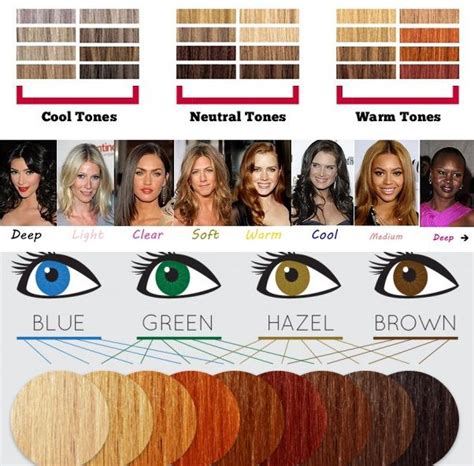When it comes to choosing a new hair color, your skin tone plays a crucial role in determining which shades will complement your complexion and enhance your overall appearance. Understanding your skin’s undertones and assessing your personal style and preferences is essential for making an informed decision that will boost your confidence and leave you feeling radiant. This comprehensive guide will delve into the nuances of skin undertones, provide expert recommendations for hair colors that flatter various skin tones, and offer insights into how to achieve and maintain your desired hue.

Understanding Skin Undertones
Skin undertones refer to the subtle, barely visible hues that lie beneath the surface of your skin. These undertones can be broadly classified into three categories: warm, cool, or neutral. Determining your skin’s undertone is crucial as it can guide you towards choosing colors that harmonize with your natural skin tone.
1. Warm Undertone:
Warm undertones often have a golden, peachy, or yellow hue to them. They pair well with hair colors that have warm tones, such as golden browns, coppers, reds, and auburn shades.
2. Cool Undertone:
Cool undertones typically have a pink, bluish, or rosy tint to them. They tend to complement hair colors that have cool tones, such as ash browns, blues, purples, and platinum blondes.
3. Neutral Undertone:
Neutral undertones have a balanced combination of both warm and cool hues. They are more versatile in terms of hair color choices and can suit a broader range of shades.
Determining Your Skin Undertone
There are several ways to determine your skin’s undertone:
1. Vein Check:
Look at the veins on the underside of your wrist. If they appear green, you likely have a warm undertone. If they appear blue or purple, you probably have a cool undertone. If you have difficulty distinguishing between the colors, you may have a neutral undertone.
2. Paper Test:
Hold a piece of white paper next to your face in natural light. If your skin appears more yellow or golden next to the paper, you have a warm undertone. If your skin appears more pink or rosy, you have a cool undertone. If your skin looks equally balanced between yellow and pink, you have a neutral undertone.
Hair Color Recommendations Based on Skin Tone
1. Fair Skin Tones:
- Warm Undertone: Golden browns, copper reds, auburn shades
- Cool Undertone: Ash browns, platinum blondes, icy blues
- Neutral Undertone: Honey blondes, light browns,caramel highlights
2. Medium Skin Tones:
- Warm Undertone: Medium browns, reddish browns, golden blonds
- Cool Undertone: Chocolate browns, ashy blondes, brunette with cool highlights
- Neutral Undertone: Mahogany reds, warm browns, toasted coconuts
3. Olive Skin Tones:
- Warm Undertone: Espresso browns, warm blacks, copper highlights
- Cool Undertone: Ashy browns, smoky grays, deep purples
- Neutral Undertone: Medium to dark browns, warm blondes, caramel highlights
4. Dark Skin Tones:
- Warm Undertone: Chocolate browns, mahogany reds, warm auburns
- Cool Undertone: Ebony blacks, dark purples, deep blues
- Neutral Undertone: Rich browns, natural black, golden honey highlights
Achieving and Maintaining Your Desired Hair Color
Once you have determined your skin’s undertone and identified the hair colors that will flatter you, it’s time to achieve your desired hue. Here are some important considerations:
1. Professional Consultation:
Consulting a professional hairstylist is essential for determining the most suitable hair color for your skin tone and personal style. They can assess your hair’s texture, condition, and current color to develop a customized hair color plan.
2. Quality Hair Dye:
Using high-quality hair dye is crucial for achieving long-lasting and vibrant results. Look for dyes that are formulated with nourishing ingredients to protect your hair from damage.
3. Follow Instructions Carefully:
Always follow the instructions provided with the hair dye to ensure proper application and avoid any potential damage to your hair.
4. Post-Treatment Care:
After coloring your hair, it’s important to follow a proper hair care routine to maintain the color and preserve the health of your hair. Use color-protecting shampoos and conditioners, deep condition your hair regularly, and minimize heat styling to prevent fading.
Conclusion
Choosing a hair color that complements your skin tone can elevate your overall appearance and enhance your self-confidence. By understanding your skin’s undertones, researching suitable hair colors, and following professional advice, you can achieve a stunning hair transformation that will make you feel radiant and beautiful. Remember to prioritize hair health, maintain your color with proper care, and embrace the transformative power of the perfect hair color.
